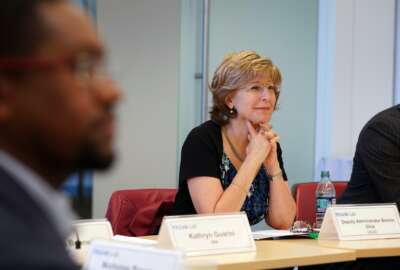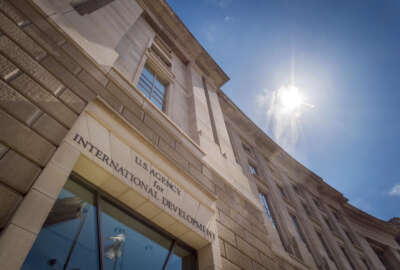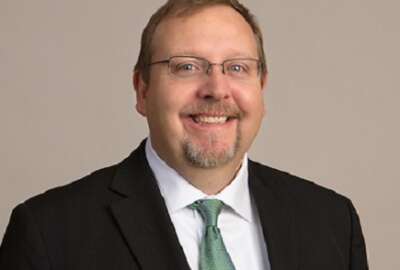
USAID makes big bets on research to help alleviate food insecurity
USAID awarded $36 million grant to the University of California, Davis, and a $25 million grant to Tufts University.
Best listening experience is on Chrome, Firefox or Safari. Subscribe to Federal Drive’s daily audio interviews on Apple Podcasts or PodcastOne.
The U. S. Agency for International Development recently awarded two large academic grants to deal with food insecurity, a problem that’s growing worse around the world. $36 million went to the University of California, Davis. And $25 million went to Tufts University. Rob Bertram, chief scientist in the Bureau for Resilience and Food Security at USAID, joined Federal Drive with Tom Temin.
Interview transcript:
Tom Temin: Mr. Bertram, good to have you on.
Rob Bertram: Thanks very much, Tom, it’s great to be here with you.
Tom Temin: Now, these are really big grants. I mean, even by federal standards, not many colleges get $36 million in a pop. So tell us what it is you hope that these two academic institutions will develop under these two grants.
Rob Bertram: So this is part of a larger program of what are called the Feed the Future Innovation Labs. Feed the Future, I’m going to start by just describing that for a minute, is the U.S. government’s what we call whole of government global food security Initiative. And this is basically seeking to reduce hunger and malnutrition and the extreme poverty that accompanies those in the countries in the world where these problems are deepest. And this especially takes us towards areas like Sub-Saharan Africa, South Asia and parts of Central America. So that’s Feed the Future. And within that, we have a science and technology and research as a key area of investment where we can leverage the tremendous capabilities of American agriculture, not just in research really, in the private sector, in farmer organizations, producer groups, civil society organizations that are working to combat hunger and malnutrition. But in this case, these grants are about leveraging the best research capabilities we have. Working together with partners in these countries help solve problems by developing new solutions that reduce hunger and poverty and malnutrition.
Tom Temin: And the solutions in these particular cases, are you looking for logistics and distribution issues? Because that’s can contribute to food insecurity. Or better agricultural methods? Or what area of the food problem are you looking to address here?
Rob Bertram: So there are 21 Feed the Future innovation labs, and you just referred to two of the newest ones. One of those, led by UC Davis — University of California, Davis — is in horticulture. The one you mentioned at Tufts is around nutrition and food systems. So that gets to the point you were just raising. But basically, this is a broad portfolio, and each of these labs involves many partners, including other universities here in the United States. We have, I think, about 70 university partners altogether, but very importantly, collaborating researchers and universities and national research organizations in the countries where we work. So these are all about partnerships. And one of the great things, Tom, here is that not only do we work together to develop innovative solutions, which can then go to scale and really drive impact on the ground and improvements, but we build capacity. We help these countries on their long-term journey where they are able to solve their own problems more effectively by developing their own agricultural and food systems and nutrition research capabilities.
Tom Temin: And just a question about the grant that went to UC Davis. You mentioned horticulture, and the press release mentions horticulture. I think of horticulture as relating to landscaping more than food, which I associate with agriculture more. So tell us how horticulture fits into the picture here.
Rob Bertram: Well, I’m really glad you flagged that. Yes, as much as we think about horticulture and the way you just mentioned — beautiful flowers and shrubs and trees. It also implies, in this case, fruits and vegetables. This is part of our effort under a new updated global food security strategy that was put together across a whole group of U.S. government organizations with USAID in the lead, but many other partners like the Department of Agriculture and the State Department and others joining in. And there were extensive consultations done with all kinds of partners globally to develop that strategy. And one of the things that strategy emphasizes is improved diet quality, to try to improve nutrition, particularly key nutrients and vitamins and minerals in the diets of really poor and vulnerable people around the world where malnutrition is still rice. And horticulture is not only an important source of improved diet quality, as we all know to eat our vegetables, right? It’s also a great way for you low Income farmers to be able to grow their incomes and their businesses to move them up out of poverty. One thing that’s worth mentioning here is when we look at hunger and malnutrition and extreme poverty in the developing world, we find that it’s concentrated in rural areas among low income, smallholder farm families. There’s hundreds of millions of them around the globe. And ironically, this is where even though they work in agriculture and produce food, they still suffer from hunger and malnutrition.
Tom Temin: We’re speaking with Rob Bertram, He’s chief scientist in the Bureau for resilience and food security at the USAID. And so, just to clarify, these grants will develop systems and ways of distributing food growing horticultural food that can be transplanted to those nations?
Rob Bertram: That’s right. The work actually takes place over there in our partner countries where we’re working. And it could be, for example, reduced post-harvest losses — for example, fruits and vegetables, where those are very high. In the nutrition research work, it could be understanding the role of food production, and the importance of women in production systems, as farmers, as extension agents, and as decision makers in improving the productivity, the incomes and the nutritional impacts from our work. And we have many other innovation labs as well. We just also announced another new lab with Pennsylvania State University on emerging and current threats to crops. So think about things like locusts and plant diseases. And so this is another case where we are marshaling the tremendous capacity of our research institutions here in the United States. One other key point, Tom, is that this comes back to benefit U.S. producers, too. We get ahead of pests and diseases, we learn more about maybe extreme climatic conditions by working on these crops and livestock and poultry and fish. All of these things that our researchers learn, and they bring back benefits to producers here in the U.S., but ultimately, to you and me, to consumers, who benefit from a safer, more affordable and abundant food supply.
Tom Temin: Now in the United States and other developed nations, agriculture has become pretty technologically intensive between the engineered seeds and so forth that are used. GPS and micro-irrigation and all of these technologies that depend on broadband, fuel supplies and a physical distribution network that’s sophisticated. So do you envision those types of elements that are ancillary to the farm itself having to be available in those countries. For example, broadband, to have a GPS directed way of managing fields and forests and so forth?
Rob Bertram: Yes, I think what you’re getting at is what we call precision agriculture, where you’re really using intensification of knowledge. It could be about the weather, it could be about the soil and the fertility of the soil, it could be about the seeds, it could be about market conditions that all support better decision making and actually getting more from less, using our resources more effectively and efficiently in ways that conserve them. So yes, the principles are similar, Tom, when we go into a context, say, for example, in Sub-Saharan Africa. But the principles are the same, but the way we would get at them would be somewhat different. But we are seeing huge impacts from, say, cell phones, where a farmer, now, she may know the price that’s being offered in the capital city for what she’s growing. And that makes her much more powerful in dealing with middlemen, you know, being able to have more of the income come on the farm. And also, at the end of the day, increase market efficiency in ways that reduce losses, make food more abundant and available for low income consumers in particular. So yes, the concepts are there. We leverage science. We are working tremendous partnerships around things like drought tolerance and heat tolerance in crops. And again, these are things that can come back and benefit American farmers as well.
Tom Temin: And finally, what are some of the timelines here? These are, again, I thought they look like big grants, you know, 36, 25, and you know, options for greater grants, and you’ll have people stationed overseas under these grants. What are the timelines? What do you see as when deliverables could be delivered?
Rob Bertram: Well, it’s important particularly in research. We need to bear in mind that these are long-term undertakings. It’s not something that you do in a day. Research, you know, almost by nature, you don’t quite know the answer. You can identify the problem but then you have to develop have the solution. So these are five-year grants. And that grant amount you mentioned, that would be over five years. And it would include both resources from our central Feed the Future budgets. Here in Washington, where we fund these programs that work across regions and globally complemented by USAID missions in the field. In many, many countries, we have US Agency for International Development missions that are partnering on the ground with local partners. And what they can do then is leverage the innovations that come from these research grants, and help take them to scale. Often, these programs are extended for a second five years or three years, whatever it happens to be, to get the job done. But that’s based on the need for that, the performance of the partners — are they achieving what they set out to achieve? So we have a real collaboration here. We stay engaged, and our university partners that lead these Feed the Future Innovation Labs — these 70 universities —including a diverse set of universities here in the United States, Tom. We have historically black colleges and universities that are partners, we leverage other minority serving institutions as well. And the idea then is those researchers are working with their partners overseas, and at least stick with it to get the job done. So it could be in five years, it could be longer based on both performance and need and impact, ultimately. Often in that second five years, we get more impact on the ground, because those technologies and better resource management practices around soil and water and innovative policies can be adopted and applied on the ground.
Tom Temin: So the next Norman Borlaug could be a woman in South Saharan Africa.
Rob Bertram: I hope it will be. And I’ll tell you, there’s a lot of great candidates out there. It’s so inspiring to see the ownership and the leadership. You know, that’s another really important thing about our work. This isn’t about us going out and giving anybody anything. It’s not even about teaching people to do things. It’s about working together with them in the lead. And in many cases, Tom, it’s our partner countries. They are co-funding this, they bought this. And frankly, it’s important that they want it because that means it’s going to be sustainable. You know, our partner countries have to believe in this work, too. It’s kind of a shift from the way people thought about foreign assistance or maybe like food aid. A lot of people think of food aid, which remains very important as a tool. But that’s very different from this long term, but really impactful development that began with Norman Borlaug, but continues today, including through many women in Sub-Saharan Africa.
Tom Temin: Alright, Rob Bertram is chief scientist in the Bureau for Resilience and Food Security at the US Agency for International Development. Thanks so much for joining me.
Unknown Speaker: It’s been a pleasure, Tom. Thanks so much.
Copyright © 2025 Federal News Network. All rights reserved. This website is not intended for users located within the European Economic Area.
Tom Temin is host of the Federal Drive and has been providing insight on federal technology and management issues for more than 30 years.
Follow @tteminWFED
Related Stories

USAID wants to make it easier for partners to compete for its grant money




